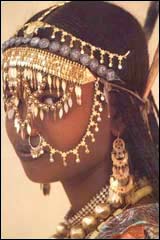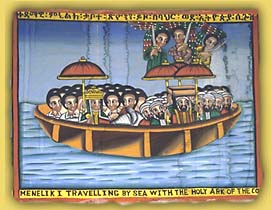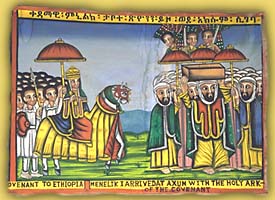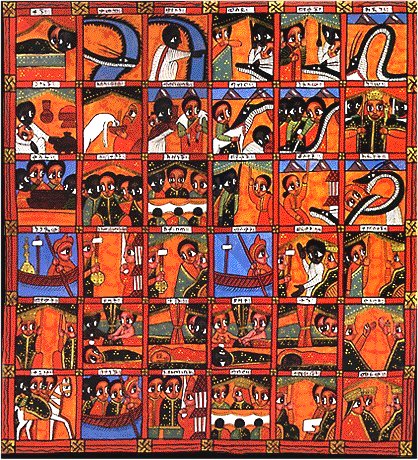

A Story of Kush, Sheba, Israel, Solomon and the Ark

Preface
This little story was written back in 1991. It tries to piece together
certain Ethiopian and Israelite writings on Judaism's importation to the
former nation. As such, it alludes to the first Israelite migrants to
the Horn and southern Arabia. Could the Ark have been spirited there for
safe keeping? This story does not attempt to present the origin of the
Beta Israel. Until recent times, the Jews of Ethiopia gave no credence
to the Kebra Nagast's rendition of matters. Where the Beta Israel are
descendants of various Israelite tribes, the Amharics and Tigreans are
indigenees (or Arabian Cushite migrants) who converted to Solomonic
Judaism and later to Christianity.

The Story
The
day came to equitably divide the earth between the sons and
grandsons of Noahh. Each one of the three sons each drew an imprinted
slip from their father's lap. Shem and his sons were specially blessed
black and beautiful. They received the inhabitable or middle portion
of the earth. Hham and his sons were blessed black like the raven.
Their inheritance was the coastlands or southern reaches of the earth.
Yafet and his sons were blessed entirely white. The desert and its
fields was their lot, the earth's northland regions.
1
Now
Noahh's sons, in turn, assigned land allotments to their own sons.
Noahh solemnized the event declaring a curse on any who would by force
take that which by lot belonged to another. The land of Hham was
aportioned like this. Kush got the eastern part, to his west Mitsraim,
to his west Fut, to his west Kanaan and west of him the ocean. After
Babel, "Hham and his sons went into the land set aside for him ...
Kanaan ... did not go to the land that had fallen to him in the west
by the sea, but settled in the land of Lebanon as far as the river of
Egypt, between the Jordan region and the sea."
2
To
all the ancient authors, the land of Kush designates that area of
the earth upon which shores lap the Indian Ocean; inhabited by a
renowned folk with skins of rich ebon hue. Sheba, a famed empire named
after a son of Kush, was situated on both shores of the Red Sea. It
included portions of today's Yemen and Ethiopia.
 Makeda or Bilqis was the last to occupy her dynasty's throne and
yet also mother to the new Solomonic dynasty, whereby her fame spread
throughout the world. During her visit with Shelomo Hamelek, Maqeda
Hamalka vowed to "not worship the sun, but will worship the Creator
of the sun, the God of Yisrael. And that tabernacle of the God of
Yisrael shall be unto me my Lady, and unto my seed after me, and unto
all my kingdoms that are under my dominion."
3
Within Israelitic canon, Shelomo Hamelek gives the Queen of
Sheba everything she desires.
4
Makeda or Bilqis was the last to occupy her dynasty's throne and
yet also mother to the new Solomonic dynasty, whereby her fame spread
throughout the world. During her visit with Shelomo Hamelek, Maqeda
Hamalka vowed to "not worship the sun, but will worship the Creator
of the sun, the God of Yisrael. And that tabernacle of the God of
Yisrael shall be unto me my Lady, and unto my seed after me, and unto
all my kingdoms that are under my dominion."
3
Within Israelitic canon, Shelomo Hamelek gives the Queen of
Sheba everything she desires.
4
Shelomo and Makeda were both much impressed with each other. So much so
that when Queen Balqis' tour of state was near an end, King Solomon's
heart was stirred: "A woman of such splendid beauty has come to me from
the ends of the earth! What do I know? Will G_d give me seed in her?"
His thoughts were the same as when he aquired his wives and concubines:
"What do I know? Peradventure G_d will give me children from each one
of these women. My children shall inherit the cities of the enemy, and
shall destroy those who worship idols."
That day the palace servants busily prepared a festal banquet in honor
of the Queen of Sheba. The menu consisted of highly seasoned meats,
peppered fish and drinks mingled with spices. The place where she sat
to eat was spread over with purpled tapestries. Fine oriental carpets
lay under her feet. All around were decorations of moschus and marble
and precious stones. The air wafted aromatic scents of myrhh, cassia
and frankincense among other costly essences. After several courses and
the meals' end the administrators, counsellors, nobles and officers
began to absent themselves. Makeda attempted to retire to her own
quarters. Solomon wouldn't hear of her departing at so late an hour.
Wasn't his residence as comfortable as the one he had arranged for her?
Makeda was the virgin queen of Ethiopia, her throne pending on that
condition. Shlomo swore to take nothing from her by force on terms
that she would take nothing of his by force.
Makeda
awoke because of extreme thirst that night. All water founts
accessable to the public were shut off! The queen's lady in waiting
was sent to Solomon's chambers to procure water. She handed the cup to
Makeda.
 Immediately Shlomo who was only half asleep grasped Balqis by
the hand saying: "Why have you broke your promise?" Afraid, Balqis
answered: "All my desire is for this water." Shlomo replied: "As you
see, nothing is more valuable than water. Release me from my vow and
be released from yours and I will give you all that you desire."
5
This is the end of what the hoopoe bird began, that the
II Alphabeta of Ben Sira, 21b,
records the marriage of Solomon and the queen of Sh*ba.
Immediately Shlomo who was only half asleep grasped Balqis by
the hand saying: "Why have you broke your promise?" Afraid, Balqis
answered: "All my desire is for this water." Shlomo replied: "As you
see, nothing is more valuable than water. Release me from my vow and
be released from yours and I will give you all that you desire."
5
This is the end of what the hoopoe bird began, that the
II Alphabeta of Ben Sira, 21b,
records the marriage of Solomon and the queen of Sh*ba.
Nikaule returns to Sheba pregnant with a son from Solomon she will
name Beyn Lekhem or Menelik. Her lady in waiting is pregnat too
with Menelik's brother Zage. Upon attaining the age of manhood the
two brothers make their way to Israel and adventure. In time they
must leave and return home.

|

|
As Menelik ben Hhakhiym was to rule Ethiopia as a Judaic kingdom,
twenty, first born Levite colonist accompanied him. A replica heikal
with other trappings/vestures went along with the entourage. Some hold
the opinion that the original Ark of the Covenant and not a copy was
removed to Yeha and later Axum, Ethiopia where today it is still
maintained in secret by the successors of those Israelite colonist
who have apostasized to Christianity. Others suppose the ark never
left Jerusalem and Yermiyahu Hanavi of Yoshiyahu Hamelek hid it in
some cave about the city or even on Mt. Nebo.
Mekilta Bahodesh 11, 73a,
tells us, "On the day upon which the one (altar) was built (that of
Shelomo), the other (that of Moshe) was hidden."
So by the year 2952 (809 BCE), 70 years after the kingdom of Judah's
establishment and 12 years before the kingdom of Israel cecedes from
the united monarchy, Malka Bilqis' conversion laid the foundation of a
"Jewish state" on both the Arabian Peninsula and Horn of Afrika shores
of the Bab el Mandeb. The subjects who converted were taught the Judaism
of the Solomonic era by the Levites and Israelites who returned to Sheba
with Menyelek I. The religion of the serpent Arwe Waynaba, which Makeda's
father Angabo suppressed, continued to be practiced by the common
population. The Kushites also remained devoted to the ancestral cult of
Hham (Amon, Mahrem) which all Hhamites professed out of reverence for
their progenitor.


SR' Yafeu ibn Taom

KEYWORDS Kush Cush Ethiopia Sheba Solomon Menelik Ark Ham
Kebra Nagast BlackJew Black Jews African Jews Japhet Canaan Noah